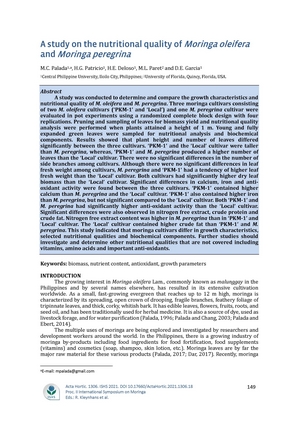Moringa - a vegetable tree for improved nutrition, health and income of smallholder farmers
요약
Moringa (Moringa oleifera) is a perennial softwood vegetable tree widely grown in the tropics of Asia, Latin America, and sub-Saharan Africa. Most parts of the tree are edible. The leaves and flowers are eaten as salad, as cooked vegetables, added to soups and sauces, or used to make tea. The young, tender pods - known as drumsticks - are highly valued as a vegetable in Asia. Moringa is nutrient-dense and rich in essential micronutrients and vitamins as well as antioxidants and bioavailable iron. According to data available at AVRDC's Nutrition Lab, moringa exceeds the micronutrient content of tomato, based on 100 g FW, by a factor of 9 to 38: β-carotene content - 15.28 mg (×38); vitamin C - 459 mg (×24); vitamin E - 25.25 mg (×22); iron - 10.09 mg (×19); folates - 93 µg (×19); antioxidant activity - 2858 TE (×9). Moringa is also rich in protein: 100 g of fresh moringa leaves contain 9.4 g of protein comprising all essential amino acids in nutritionally balanced proportions. Boiling fresh moringa leaves and dried powder in water enhances aqueous antioxidant activity and increases bioavailable iron by a factor of 3. Dried leaf powder is processed into moringa capsules and used as a dietary supplement. Depending on the genotype, leaf fresh weight of the first two harvests ranges from 560 g to 2.3 kg plant-1. Total fresh matter yield at first harvest (leaves and young shoots) depends on plant density and varies from 19.6 to 78 t ha-1 with a plant density of 95,000 and 1 million plants, respectively. Moringa has great potential to generate income for smallholder farmers and to enhance environmental services by controlling soil and wind erosion, and by providing shade and clean water. Given its multiple uses and wide range of adaptability, moringa is an ideal crop for sustainable food production.
기술
Conference paper
추천 인용
Ebert, A. W. and Palada, M. C. (2017). Moringa - a vegetable tree for improved nutrition, health and income of smallholder farmers. In In Ebert, A. W. and Palada, M.C. (Eds.), I International Symposium on Moringa (pp. 309-315). International Society for Horticultural Science. https://doi.org/10.17660/ActaHortic.2017.1158.35
유형
Conference paperISSN
0567-7572; 2406-6168ISBN
978-94-62611-55-9키워드
시리즈
ISHS Acta Horticulturae;1158Collections
- Conference papers [17]
Related items
Showing items related by title, author, creator and subject.
-
A study on the nutritional quality of Moringa oleifera and Moringa peregrina
Palada, Manuel C.; Patricio, Hope G.; Deloso, Homer E.; Paret, Mathews; Garcia, D. E. (International Society for Horticultural Science, 2021-04-15)A study was conducted to determine and compare the growth characteristics and nutritional quality of <em>M. oleifera</em> and <em>M. peregrina</em>. Three moringa cultivars consisting of two <em>M. oleifera</em> cultivars ... -
Evaluation of the efficacy of essential oil from moringa leaves (Moringa oleifera) against Staphylococcus epidermidis
Mañosa, Rhegil Joseph B. (2024-04)Staphylococcus epidermidis is a coagulase-negative and gram-positive bacterium that can cause arthritis, tendinitis, tenosynovitis, osteomyelitis and omphalitis in poultry animals. It is the most common cause of nosocomial ... -
Brooding performance of Philippine native chicken supplemented with moringa (Moringa oleifera Lam.) and hot red pepper (Capsicum annum L.) as mineral and vitamin premix
Servidad, Layka A. (2019-04)The study was conducted from February 21 to March 14, 2018 at CPU-CARES Research and Development Learning Center, Jaro, Iloilo City. The study was conducted to determine the brooding performance of Philippine native chicken ...







